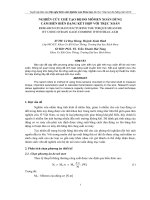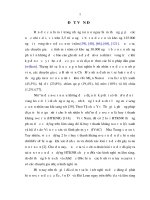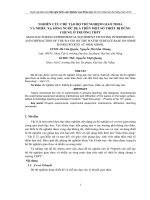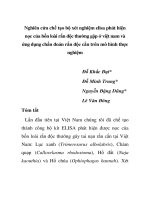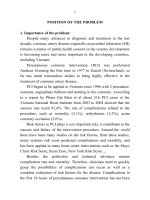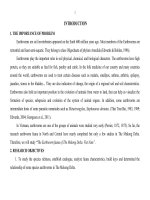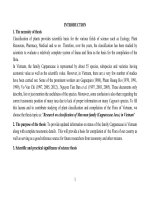nghiên cứu chế tạo bộ xét nghiệm elisa phát hiện nọc rắn độc và ứng dụng lâm sàng chuẩn đoán rắn độc cắn ở việt nam bản tóm tắt tiếng anh
Bạn đang xem bản rút gọn của tài liệu. Xem và tải ngay bản đầy đủ của tài liệu tại đây (178.43 KB, 25 trang )
1
RATIONALE
Snakebite is one of danger of common accidents in tropical
countries, with over 2.5 million people are bitten by venomous
sankes and about 125,000 people die by venomous snakebites each
year. According to experts about 30,000 people are bitten by snakes
in our country each year. Statistical data of nearly two thousand
patients bitten by venomous snakes at Cho Ray Hospital showed that
species of venomous snakes usually cause the most accidents in the
Southern region of Vietnam is Trimeresurus albolabris (43,3%),
Naja kaouthia (23,8%), Calloselasma rhodostoma (19,4%), Naja
siamensis (10%) and Ophiophagus hannah (1,2%).
In Vietnam, there are two types of commercial antivenom serum
specific with venoms of Trimeresurus albolabris and Naja kaouthia
are being used in clinical. However, the diagnosis of specices of
venomous snakebite to use antivenom serum is depend on clinical
experience and have not a test for detection of snake venoms.
There are many immune techniques is applied to detect snake
venom, in which the enzyme linked – immuno sorbant assay
(ELISA) is often used to develop the test for detection of snake
venom.
From the above theoretical and practical, subject: “Development
of ELISA kit for detection of snake venoms and clinical
application for snake bite diagnosis in Vietnam” was done for
aims:
1. Fabrication of an AB-ELISA kit for detection venoms of four
snake species of Trimeresurus albolabris, Naja kaouthia,
Calloselasma rhodostoma, Ophiophagus hannah and development
2
of an AbE-ELISA kit for detection of venom of two species of
Trimeresurus albolabris and Naja kaouthia in Vietnam.
2. Assessing the efficacy for detection venoms and venomous snake
species identification of ELISA kit in clinical specimens.
The main new scientific contributions of the thesis:
This research has succeed in development of an AB-ELISA kit
for detection venoms of four snake species: Trimeresurus albolabris,
Naja naja kaouthia, Calloselasma rhodostoma and Ophiophagus
hannah.
This is the first time in Vietnam, antivenoms produced by IVAC
in Nha Trang city (products clinically used for treatment of snake
bite) have been used to develope the AbE-ELISA for detection
venoms of two species: Trimeresurus albolabris and Naja naja
kaouthia.
Both AB-ELISA and AbE-ELISA have ability for detection of
standard snake venom samples at levels lower than 4 ng/ml,
depending on sample types such as blood, plasma, urine, buffer and
type of snake venoms. AbE-ELISA kit has ability for detection of
Trimeresurus Albolabris and Naja kaouthia in all kind of assay
samples in clinical, include: whole blood, urine and blister fluid.
The layout of the thesis:
The thesis consists of 112 pages with 19 figures, 3 diagrams, 10
charts and 15 tables, in which: retionale (2 pages); Introduction (33
pages); Introduction (33 pages); Materials and menthods (22 pages);
Result (27 pages); Discussion (25 pages); Conclusion (2 pages);
Recommendation (1 page); References 122 documents (Vietnamese
12, English 110).
3
CHAPTER 1: LITERATURE REVIEW
1.1. ACCIDENT AND DIAGNOSIS OF VENOMOUS SNAKE
BITE
1.1.1. Common venomous snakes causing snake bite accident in
Vietnam
According to Tran Kien and Nguyen Quoc Thang (1995),
Vietnam has more than hundred species of snakes, including
venomous snakes dozens that distribute both on land and underwater.
In which, some common venomous snakes species cause venomous
snakebite in Vietnam: Trimeresurus albolabris, Naja naja kaouthia,
Calloselasma rhodostoma, Naja naja siamensis and Ophiophagus
hannah
1.1.2. Clinical characteristics of venomous snakebites
The clinical symptoms of snakebite envenomation patients are
varied and plentiful, including local and systemic symptoms.
1.1.3. Diagnosis of venomous snakebite in Vietnam
Diagnosis of venomous snakebite in Vietnam is mainly based on
clinical symptoms and have no test for detection snake venom is
studied and applied to diagnosis of snakebite species identification in
clinical. So development of test for detection of snake venom and
application in diagnosis of venomous snakebite species is necessary
requirements in Vietnam.
1.2. SNAKE ANTIVENOM ANTIBODIES AND
IMMUNOLOGICAL TECHNIQUES FOR DETECTION OF
SNAKE VENOM
1.2.1. Snake antivenom antibodies
1.2.2. Immunological techniques for detection of snake venom
4
13. ELISA
1.3.1. Selection of ELISA test for detection of snake venom
Although many immunological techniques for detection of
venomous snake venom are studied and applied as in section 1.2.2.
However, the most immune technique for detection of venomous
snake venom in manufacture of test is ELISA.
1.3.2. Designs of ELISA applied in developing tests for detection
of snake venom
- General principle of ELISA test: the use of antigen or antibody as
marker to detect antigen-antibody complexs by color indicator.
- Design of sandwich ELISA using two antibodies pattern
Design of sandwich ELISA avidin-biotin (AB-ELISA): consist
of capture antibody, detection antibody conjugated biotin, HRP
conjugated avidin and substrate solution to detect antigen-antibody
complexes.
- Design of sandwich ELISA using three antibodies pattern
Design of sandwich AbE-ELISA using three antibodies pattern:
consist of one capture antibodies, detection antibodies is an antigen
specific antibodies but have different productive origins with capture
antibodies. HRP conjugated antibodies that specific to detection
antibodies and substrate solution to detect antigen – antibody
complexs. In this design of test, detection antibodies have not
conjugated enzyme or biotin so the stability and efficacy of this are
better than detection antibodies used in the above design. HRP
conjugated antibodies that specific to detection antibodies can be
supplied by commercial company so it has higher specific and
stability.
5
1.3.3. Criteria in evaluation of an ELISA
In development of ELISA for detection of snake venom,
evaluation of criterias are often interested in specificity, sensitivity,
stability and testing time.
1.3.4. The commercial ELISA kit for detection of snake venom
Up to now, there are two snake venom detection kits that was
developed in Australia and India. However, these are not suitable for
detection of venomous snake venom in Vietnam.
CHAPTER 2
MATERIALS AND METHODS
2.1. SUBJECTS AND STUDY MATERIALS
2.1.1. Subjects of study
- Studies of creating anti-snake venoms monospecific rabbit serum
Twelve healthy gray male rabbits, weighing from 2 to 2,5
kilograms were divided to 4 groups and each group had 3 rabbits.
- Studies of effectiveness assessing the detection of snake venoms of
ELISA kit in clinical
Specimens for detection of snake venoms including 115 whole
bloods, 119 urines and 4 blisters were taken from 122 patients who
was bitten by venomous snake and treated at the Department of
Tropical Diseases in Cho Ray Hospital in Ho Chi Minh city.
2.1.2. Materials
Total venom of four venomous snake species (Trimeresurus
albolabris, Naja kaouthia, Calloselasma rhodostoma and
Ophiophagus hannah) in lyophilized form, the research products of
KCB.04.06.01 project that has accepted in 2009. The chemical,
biological and research equiments are standard analyzed that supply
by reputable manufactures.
6
2.2. METHODOLOGY
2.2.1. Creating antigen and immunizing to produce rabbit anti-
snakevenom antiserum
2.2.1.1. Creating snakevenom antigen
4 snakevenoms antigens were created from 4 lyophilized
snakevenom samples, by method described by Selvanayagam and et
al (1999).
2.2.1.2. Immunizing rabbit with the snakevenom antigen
Rabbits were divided into 4 groups, each group had 3 rabbits: the
processing of immunized like the protocol of Chotwiwatthanakun
and et al (2001) is a low dose, low volume, multi-site injection along
the spine tip and booster.
2.2.2. Indirect ELISA assay
- Identify specific antibodies titer of anti-snakevenom serum
- Assessment of cross reactivity between mono-specific anti-
snakevenom serum and venoms of other snakes
2.2.3. Purification of antibodies
Antibodies specific for each species of snake venoms was
extracted and purified by three steps purification process:
* Step 1: extraction IgG from rabbit serum by affinity
chromatography with protein G column.
* Step 2: extraction venom specific IgG from total IgG by immune –
chromatography with column contains specific snakevenom antigen.
* Step 3: remove the antibodies molecules that cross-reactivity
between snake species by immune adsorbtion menthod with allergic
snakevenom antigen column.
2.2.4. Biotinylation of antibodies
7
2.2.5. Preparation of mono-specific horse antiserum against
Trimeresurus albolabris and Naja kaouthia supplied by IVAC
2.2.6. AB-ELISA kit for detection of snakevenom
2.2.6.1. Design AB-ELISA kit
The kit is built on the principle of sandwich ELISA with Avidin-
Biotin complex .
2.2.6.3. Protocols of AB-ELISA assay
- Step 1: AB-ELISA kits are mounted on racks.
- Step 2: add 100 µl sample (whole blood, plasma, serum, urine,
blister ).
- Step 3: add 100 µl biotin conjugated detection antibodies.
- Step 4: add 100 µl avidin – HRP conjugated into each well.
- Step 5: add into each well 100 µl OPD substrate at concentration
0,5 mg/ml that supplemented with 0,006 % H
2
O
2
. Read result after 5
minutes.
Test validation:
- Positive: OD
sample
> X
OD negative control
+ 3SD
- Negative: OD
sample
≤ X
OD negative control
+ 3SD
2.2.6.4. Evaluating the stability and efficiency of AB-ELISA kit in the
laboratory in detecting snakevenom
The stability of AB-ELISA are checked once a month during the
first six months after production.
Efficiency of detection for venomous snake venom of AB-ELISA
in the laboratory are evaluated base on their ability to detect standard
snakevenom sample in PBS-T solution, serum or plasma, whole
blood and urine at different concentrations: 32 ng/ml; 16 ng/ml; 8
ng/ml; 4 ng/ml; 2 ng/ml; 1 ng/ml; 0,5 ng/ml and 0,25 ng/ml.
8
2.2.7. AbE-ELISA kit for detection of venomous snakevenom
2.2.7.1. Design AbE-ELISA kit
The kit is built on the principle of sandwich ELISA with 3
specific antibodies (horse antibody, rabbit IgG antibody and HRP
conjugated mouse antibody that anti rabbit IgG).
2.2.7.3. Protocols of AbE-ELISA assay
Consists of 5 steps similar to those in the section 2.2.6.3
Test validation:
- Positive: OD
sample
> X
OD negative control
+ 3SD
- Negative: OD
sample
≤ X
OD negative control
+ 3SD
2.2.7.6. Evaluating the stability and efficiency of AbE-ELISA kit in
the laboratory in detecting snakevenom
Similar to the method described in section 2.2.6.4
2.2.8. Assessing the efficacy for detection venoms and venomous
snake species identification of ELISA kit in clinial specimens
* Step 1: Complete the document of clinical trial research and
collected sample from the patients were envenomed by snakebite.
* Step 2: Evaluate effectiveness of detection for venomous snake
venom by done the AbE-ELISA assay in the process described in
section 2.2.7.3 for all collected samples.
* Step 3: The evaluation of suitability between snake bite species
confirmed diagnosis by ELISA kit and snake bite species confirmed
diagnosis by clinical base on KAPPA coefficient.
2.3. DATA ANALYSIS
Research data is analyzed according to the method of biomedical
statistics
9
Figure 2.1. Research model
10
CHAPTER 3
RESULTS
3.1. AB-ELISA KIT FOR DETECTION OF VENOMS OF 4
SNAKE SPECIES: Trimeresurus albolabris, Naja kaouthia,
Calloselasma rhodostoma and Ophiophagus hannah
3.1.1. Four rabbit antibodies specific to snake species are used in
AB-ELISA kit
Chart 3.4. Result of indirect ELISA for snake species specificity
assessment of anti snake venom antibodies
Comment: Purity rabbit IgG antibodies specific to snake species has
strong reaction to the correlative venom, can be considered the
purity antibodies is snake species specific antibodies.
3.1.2. AB-ELISA kit for detection of venomous snake venom
1050 tests were made with test for sensitivity, stability survey and
clinical trials.
11
3.1.3. The sensitivity and ability to detect venomous snake
venom of AB-ELISA in the laboratory
Table 3.1. The sensitivity of AB-ELISA kit for detection of
venomous snake venom
Samples
Sensitivity (ng/ml)
T.
Albolabris
C.
Rhodostoma
N.
Kaouthia
O.
Hannah
Whole blood
Plasma
Serum
Urine
Buffer
solution
3,2
1,6
0,8
1,6
0,8
3,2
0,8
0,8
1,6
0,8
1,6
0,8
0,8
1,6
0,4
1,6
0,8
0,8
3,2
0,4
Comment: Results showed that AB-ELISA kit can detect venom of
all kind of samples and the sensitivity of the assay is different depend
on each type of sample and snake venom, but this assay can detect
the venom level at < 3,2 ng/ml.
3.1.4. The stability of AB-ELISA kit
Chart 3.6. Stability of AB-ELISA kit store at 4 C
Comment: The stability of kit are less than 3 months
12
3.2. AbE-ELISA KIT FOR DETECTION OF 2 SNAKE
VENOMS T. ALBOLABRIS AND N. KAOUTHIA
3.2.1. AbE-ELISA kit for detection of venoms of T. Albolabris
and N. Kaouthia
720 tests (240 test bars) were made for sensitivity testing, stability
survey and clinical trials.
3.2.2. Optimal conditions of AbE-ELISA reactions
The optimal conditions for AbE-ELISA reactions obtained as follow:
- Horse antibodies coated in wells: 5,0 µg/ml
- Rabbit IgG antibidies specific for T. Albolabris and N. Kaouthia:
2,0 µg/ml
- HRP conjugated mice antibodies that anti rabbit IgG (antirabbit
IgG – HRP): diluted 1/10,000
- Incubation time of color substrate: 5 minutes
3.2.3. The sensitivity and ability to detect venomous snake venom
of AbE-ELISA kit in the laboratory
Table 3.6. The sensitivity of AbE-ELISA kit for detection of
venomous snake venom
Samples
Sensitivity (ng/ml)
Venom of
T. albolabris
Venom of
N. kaouthia
Whole blood
Plasma
Urine
Buffer solution
4,0
2,0
2,0
1,0
2,0
1,0
1,0
0,5
Comment: The assay can detect venomous snake venom of all kind
of samples and the sensitivity of the test is different depend on each
13
type of sample and snake venom. However, this test can detect
venom level at nanograms of whole blood, plasma and urine.
3.2.4. Cross-reactivity of AbE-ELISA assay with venoms of other
venomous snakes in Vietnam
Chart 3.8. Cross-reactivity of AbE-ELISA assay with venoms of
other venomous snakes at concentration 25 ng/mL
Comment: at all concentrations examined, OD values of wells that
specific reaction are significantly higher than the remaining wells as
negative control wells and cross-reactivity wells.
3.2.5. The stability of AbE-ELISA kit
Chart 3.9. the stability of AbE-ELISA kit store at 4 C
Comment: The OD values of positive control of AbE-ELISA kit are
not difference between period of 3 months and 6 months while the
14
kit storage at 4
o
C. The kit is stable for 6 months from date of
manufacture.
3.3. ASSESSING THE EFFICACY FOR DETECTION
VENOMS AND VENOMOUS SNAKE SPECIES
IDENTIFICATION OF ELISA KIT IN CLINICAL
SPECIMENS
3.3.1. Characteristics of study subjects
3.3.2. The assay results for detection of venoms and venomous
snake species identification of AbE-ELISA kit in clinical
specimens
Table 3.11. The assay results of AbE-ELISA kit of specimens:
blood, urine and blister
The assay results
ELISA
Positive
Negative
T. albolabris
N. kaouthia
Blood(n = 115)
23
6
86
Percentage of positive
25,2 %
Urine (n = 119)
45
8
66
Percentage of positive
44,5 %
Blister (n = 4)
0
2
2
Percentage of positive
50%
Total specimens
(n = 238)
84
154
Comment: percentage of positive for blood samples is 25,2% and
urine samples is higher as 44,5%. Percentage of positive for blister
samples is 2/4 = 50%.
15
Bảng 3.12. The results AbE-ELISA assay for detection of venom
of T. albolabris along with clinical diagnosis to identify species of
snake bite
Clinical
ELISA assay
Bitten by
T. albolabris
No bitten by
T. albolabris
Sum
Positive
45 (62,5 %)
1 (2 %)
46
Negative
27 (37,5 %)
49 (98 %)
76
Sum
72 (100%)
50 (100 %)
122
KAPPA = 0,56
Comment: The positive results of AbE-ELISA assay for detection of
T. Albolabris venom in specimens of patients who had clinial
diagnosis: bitten by T. Albolabris is 62,5%. The efficacy of defind
diagnosis for T. Albolabris species bite by AbE-ELISA assays are
consistent with diagnosis for T. Albolabris species bite in clinical
with KAPPA = 0,56.
Table 3.13. The result of AbE-ELISA assays for detection of T.
Albolabris venoms along with clinical diagnosis to distinguish
envenomization levels by T. Albolabris bite.
Clinical
ELISA assay
Biiten by T. Albolabris
have uncoagulated
Biiten by T. Albolabris
have not uncoagulated
Positive
30 (81,1 %)
15 (42,9 %)
Negative
7 (18,9 %)
20 (57,1 %)
Sum
n = 37 (100 %)
n = 35 (100 %)
Comment: The positive results of AbE-ELISA assay for detection of
T. Albolabris venom in specimens of patients who had clinial
diagnosis: bitten by T. Albolabris have uncoagulated is 81,1% and an
other group: bitten by T. Albolabris have not uncoagulated is 42,9 %
16
Table 3.14. The result of AbE-ELISA assay for detection of naja
kaouthia venom in clinical
Clinical
ELISA assay
Bitten by
common cobra
No bitten by
common cobra
Sum
Positive
13 (68,4 %)
0 (0 %)
13
Negative
6 (31,6 %)
103 (100 %)
109
Sum
19 (100 %)
103 (100 %)
122
KAPPA = 0,78
Comment: The positive results of AbE-ELISA assay for detection of
n. kaouthia venom in specimens of patients who had clinial
diagnosis: bitten by common cobra is 68,4%. The efficacy of defind
diagnosis for common cobra species bite by AbE-ELISA assays are
consistent with diagnosis for common cobra species bite in clinical
with KAPPA = 0,78.
Table 3.15. The result distribution of detection for venomous
snake venom along with sample collection time after being bitten
Type of spicemens
and positive rate
ELISA assay
First 3 hours
3-24 hours
After 24
hours
+
-
+
-
+
-
Blood (n=115)
7
13
21
47
1
26
Positive rate (+)
7/20 (35%)
21/68 (30,9%)
1/27 (3,7%)
urine (n=119)
9
14
35
33
9
19
Positive rate (+)
9/23 (39,1%)
35/68 (51,5%)
9/28 (32,1%)
Blister (n=4)
1
1
1
1
Positive rate (+)
1/2
1/2
17
Comment: The result showed that positive rate of AbE-ELISA assay
in the blood and urine samples was similar to rates of 35% and
39,1% within first 3 hours after being bitten. The positive rate of
AbE-ELISA assay during the period from 3 hours to 24 hours in
urine samples was 51,5% after being bitten, while the proportion was
only 30,9% of blood samples. The AbE-ELISA kit is still possible to
detect venom in urine samples with positive rate was 32,1% after 24
hours being bitten. There is only one case of positive assay result for
blood samples at 28 hours after being bitten as 3,7%.
CHAPTER 4
DISCUSSION
4.1. AB-ELISA KIT FOR DETECTION VENOMS OF 4
SNAKE SPECIES: Trimeresurus albolabris, Naja kaouthia,
Calloselasma rhodostoma and Ophiophagus hannah
4.1.2. AB-ELISA kit for detection venoms of 4 snake species:
Trimeresurus albolabris, Naja kaouthia, Calloselasma rhodostoma
and Ophiophagus hannah
AB-ELISA kit manufactured by us also use 8 wells of a flat
bottom bar as describded in the kit of Cox. The kit is capable for
simultaneous detection of 4 common venomous snake venom in
Vietnam: Trimeresurus albolabris, Naja kaouthia, Calloselasma
rhodostoma and Ophiophagus hannah. The ability of detection for
sanke venom is increased by the use of conjugate avidin-biotin, It is
more hundreds of times than the use of agglutination technique and
detection sensitivity is the same in the use of enzyme labeled
antibidy. This has been demonstrated in the study of Ernesto Amuy
1997,Selvanayagam et al (1999) and Le Van Dong et al (2003).
18
4.1.3. The sensitivity of AB-ELISA kit
The sensitivity of AB-ELISA assay for detection of venomous
snake venom are presented in table 3.1 show that the assay can detect
to venom at all kind of specimens include whole blood, plasma,
serum, urine and buffer solution with snake venom detection
sensitivity in the buffer solution from 0,4 to 0,8 ng/ml. The
sensitivity of AB-ELISA for detection of venom in our study results
is similar to the research of other authors and at ng/ml level.
4.1.4. The stability of AB-ELISA kit
A major limitation that we encountered when making AB-ELISA
kit for detection of venomous snake venom is stability time of this kit
less than three months.
4.2. AbE-ELISA KIT FOR DETECTION VENOM OF 2
SNAKE SPECIES Trimeresurus albolabris and Naja kaouthia.
4.2.1. AbE-ELISA kit for detection venom of 2 snake species
Trimeresurus albolabris and Naja kaouthia.
The AbE-ELISA kits are also made of the same materials that are
used in AB-ELISA kit. However, that only capable of simultaneous
detection of 2 types of venomous snake venom is Trimeresurus
albolabris and Naja kaouthia but not 4 types of venomous snake
venom as AB-ELISA kit. These kits are designed base on princple of
sandwich ELISA (3 antibodies). In this study, the horse antibodies of
commercial anti snake venom serum that being used in clinical by
IVAC producer for coated. Detection antibodies are rabbit IgG
antibodies specific to snake venom after purified and HRP
conjugated mouse antibody that anti rabbit IgG.
The model of AbE-ELISA kit for detection of snake venom in
this study is consistent with the model of 3 antibodies sandwich
19
ELISA assay of Selvanayagam (1999) and Hung Dong Zong (2003).
4.2.3. The sensitivity of AbE-ELISA assay
The sensitivity of AbE-ELISA assay also at ng/ml level and the
lowest in buffer solution is 0,5 – 1 ng/ml depend on the type of snake
venoms. The sensitivity of AbE-ELISA assay for detection of
venomous snake venom in this study is similar to the sensitivity for
detection of venomous snake venom of 3 antibodies sandwich
ELISA kit manufactured by Selvanayagam in 1999 and Hung Dong-
Zong et al in 2003. The AbE-ELISA kits in this study have
demonstrated the ability detection of venomous snake venom in
biological fluids such as whole blood, plasma and urine.
4.2.4. The cross-reactivity of AbE-ELISA assay with some
venoms of other venomous snake species in Vietnam
By using 4 standard snake venoms of Trimeresurus albolabris,
Naja kaouthia, Calloselasma rhodostoma and Ophiophagus hannah
in difference concentrations to do AbE-ELISA assay. We found that,
there is no false positive reaction of kit for detection venom of
Trimeresurus albolabris and Naja kaouthia with 3 kind of other
standard snake venoms at all levels of standard snake venom < 200
ng/ml that were surveyed.
4.2.5. The stability of AbE-ELISA kit
The stability of AbE-ELISA kit has better than AB-ELISA kit
with 6 months stability time in storage condition at 4
0
C. The AbE-
ELISA kits have better stability because of biologicals use in
fabrication of kits are commercial biologicals, such as horse serum
from IVAC specific for venom of Trimeresurus albolabris and Naja
kaouthia that demonstrated to effective in clinical treatment and
response “directly” between anti snake venom serum and venom in
20
the victems’s body. HRP conjugated mouse antibody that anti rabbit
IgG was suppled by Sigma of America. The rabbit IgG specific for
snake species was obtained in this study in form of total IgG that not
conjugated enzyme or biotin so it has higher stability.
4.3. THE EFFICACY OF DETECTION VENOMS AND
VENOMOUS SNAKE SPECIES IDENTIFICATION OF ELISA
KIT IN CLINICAL SPECIMENS
4.3.2. The result of AbE-ELISA assay for detection venoms and
venomous snake species identification in clinial specimens
- The result of AbE-ELISA assay in specimens: blood, urine and
blister
In this study, AbE-ELISA assay was detected venomous snake
venom of all types of clinical specimens as whole blood, urine and
blister.
- The result of AbE-ELISA assay for detection of T. Albolabris
venoms
The positive results of AbE-ELISA assay for detection of T.
Albolabris venom of patients who had clinial diagnosis: bitten by T.
Albolabris is high rate as 62,5%. The result of ELISA is positive or
negative depending on the venom concentration of the specime of
patients. The concentration of venom depends on the amount of
venom into the victim’s body after bitten by snake and time of
specimen collection.
Clinically, they devided patients who were bitten by T.
Albolabris into two groups: group of systemic envenomation
(patients have uncoagulated) and low level envenomation or non
systemic envenomation (patients have not uncoagulated). The
positive results of AbE-ELISA assay for detection of T. Albolabris
21
venom of patients who had clinial diagnosis: bitten by T. Albolabris
have uncoagulated with high rate is 81,1% (table 3.13). The result is
entirely consistent with clinical practice because the T. Albolabris
venom in blood and urine of patients were bitten by T. Albolabris
and have uncoagulated is higher than of patients were bitten by T.
Albolabris and have not uncoagulated.
- The result of AbE-ELISA assay for detection of N. Kaouthia
venoms
The positive results of AbE-ELISA assay for detection of n.
kaouthia venom in specimens of patients who had clinial diagnosis:
bitten by common cobra (naja kaouthia and naja siamensis) is 68,4%
(table 3.14). Although the specimens of patients who bitten by
common cobra (naja kaouthia and naja siamensis) is not much, but
the results showed that cross-reactivity occurs in specimens of
pateints who bitten by naja siamensis, while the positive results of
our test is naja kaouthia venom. Thus, ELISA assay for detection of
naja kaouthia venom in this study was only able to distinguish
between patients who bitten by common cobra and patients who
bitten by another neurotoxic snakes.
- The results of AbE-ELISA assay for detection of venomous snake
venom along with sample collection time
The result showed that positive rate of AbE-ELISA assay in the
blood and urine samples was similar to rates of 35% and 39,1%
within first 3 hours after being bitten (table 3.15). Thus, the results of
our study show that venomous snake venom appears in blood and
urine before 3 hours after being bitten. Specifically, we can detect
venomous snake venom in urine after 2 hours of being bitten.
22
In the period of time from 3 to 24 hours after being bitten, the
positive rate of AbE-ELISA assay in urine samples is higher than in
blood samples with respectively rate 51,5% and 30,9% (table 3.15).
This is entirely appropriate because: urinary is the main excretion of
poison out of the body. The venom level of patients who severe
poisoning is tend to higher than patients who without severe
poisoning, the result is excreted much more in urine that make the
positive rate is higher. Beisde of it, urine has reuptake water and
concentrate mechanism so venom level in urine at the time of
sampling of venom is still high enough to positive tests when in the
blood samples are negative tests.
The AbE-ELISA kit is still possible to detect venom in urine
samples with positive rate was 32,1% after 24 hours of being bitten.
Results is consistent with published results of Sueli (2010) about the
duration of venom of urine in first seven days after venom injection.
There is only one case of positive assay result for blood samples at
28 hours after being bitten as 3,7%. Thus, the positive rate of ELISA
assay for detection of venom in blood samples after 24 hours is very
low. Results of this study showed that we should only blood samples
collected for detection of venomous snake venom within first 24
hours of being bitten. After 24 hours, we should only urine or blister
(if any) samples collected for the test.
- The efficacy of bitten by venomous snake species identification
of AbE-ELISA assay with bitten by venomous snake species
identification in clinical
Results of KAPPA coefficient estimate in table 3.12 showed that,
if AbE-ELISA kit used as diagnosis tools for identification of bitten
by T. Albolabris species when patients into hospital are consistent
23
with clinical diagnosis when patients discharged with KAPPA =
0,56. Results of KAPPA coefficient estimate in table 3.14 showed
that, compare confirm diagnosis of bitten by cobra species of AbE-
ELISA assay when patients into hospital to clinical diagnosis when
patients was discharged with consistent higher (KAPPA = 0,78).
CONCLUSIONS
1. An AB-ELISA-based venom detection kit was created for four
snake species of Trimeresurus albolabris, Naja kaouthia,
Calloselasma rhodostoma, Ophiophagus hannah; also, an AbE-
ELISA venom detection kit has been successfully developed for
two snake species of Trimeresurus albolabris and Naja kaouthia
in Vietnam, with the following specifications.
- AB-ELISA kits are able to detect and distinguigh standard
venom of 4 venomous snake species: Trimeresurus albolabris, Naja
kaouthia, Calloselasma rhodostoma, Ophiophagus hannah that
dissolved into the whole blood, plasma, urine and fluid buffer with
detection thresholds ranging from 0,4 to 3,2 ng/ml depending on the
type of snake venoms and samples. The stability of kit was not
exceed 3 months from the date of manufactured while stored 4
0
C
conditions.
- AbE-ELISA kits are able to detect and distinguigh standard
venom of Trimeresurus albolabris and Naja kaouthia that dissolved
into the whole blood, plasma, urine and fluid buffer with detection
thresholds ranging from 0,5 to 4 ng/ml depending on the type of
snake venoms and samples. The stability of kit was over 6 months
from the date of manufactured while stored 4
0
C conditions.
2. Analysis of 115 blood, 119 urine and 4 blister samples from
122 snakebite patients hospitalized and treated at Cho Ray
24
Hospital showed the efficacy for detection venoms and venomous
snake species identification of ELISA kit in clinical specimens as
follows:
- AbE-ELISA kit was able to detect Trimeresurus albolabris and
Naja kaouthia venoms of all types of clinical specimens include:
whole blood, urine and blister with positive rate respectively: 25,2%;
44,5% và 50 %. The detection rate of T. Albolabris venom of patient
group with clinial diagnosis: bitten by T. Albolabris is 62,5%. This
rate is significantly higher than in patients who was bitten by T.
Albolabris with systemic venomous and treated by anti T. Albolabris
venom is 81,1%. The detection rate of cobra venoms (naja kaouthia
and naja siamensis) of patient group with clinical diagnosis bitten by
cobra is 68,4%.
- Confirm diagnosis of T. Albolabris species by AbE-ELISA
assay when into the hospital are consistent with clinical diagnosis
when discharged with KAPPA = 0,56. Confirm diagnosis of cobra
species (naja kaouthia and naja siamensis) by AbE-ELISA assay
when into the hospital are consistent with clinical diagnosis when
discharged with KAPPA = 0,78.
PROPOSALS OF FURTHER STUDIES
AbE-ELISA kit should be applied for diagnosis of venomous
snake species in emergency and treatment facilities of bitten by
venomous snake, to contribute expansion of assignment and early
anti snake venom used, reduce the mortality and sequelae rate for
venomous snake bite victims in our country.
To get the commercial AbE-ELISA kit, the subject should be
continued to research for development and improvement of AbE-
25
ELISA kits to establish the sensitivity and specificity of kits base on
many kind of venom sample panels.
